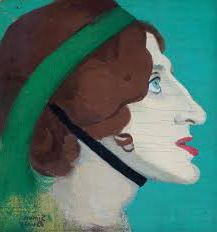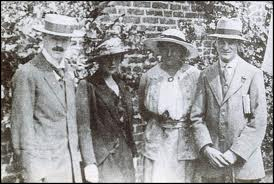|
 ATHERINE Mansfield played a significant role in both Lawrence's
life and his writings.
ATHERINE Mansfield played a significant role in both Lawrence's
life and his writings.
It is widely accepted that Lawrence based part of the character
Gudrun in Women in Love on Katherine, and she featured in
several other of his works (including his short story Smile and
as Anabel in his 1920 play Touch and Go). But this role was
greater than has hitherto been acknowledged.
It is also widely accepted that Lawrence used actual people - people
he knew personally - as the basis of his fictional characters, either
directly, or as amalgams, combining the characteristics of several
real people in the one fictional character. Often these character-elements
were drawn from people he knew at the time he was writing a novel.
A notorious example is his thinly-disguised portrait of Lady Ottoline
Morrell as Hermione Roddice in Women in Love. At the time
of writing that novel Lawrence was a constant visitor to Garsington,
Ottoline's manor house outside Oxford.
|

Lady
Ottoline Morrell - painting by
Simon Bussy
|
Between 1913 and 1918 Lawrence and Katherine Mansfield were close
friends, and at one period, near neighbours. Katherine and her partner
(later husband) John Middleton Murry were the principal witnesses
at Lawrence's marriage to Frieda in 1914, and Katherine wore to
her dying day the surplus wedding ring from her previous marriage
bestowed on her by Frieda. Lawrence was deeply involved in Katherine's
life at that time - the period leading up to the completion of The
Lost Girl.
|

The
Lawrences' wedding. L to r John Middleton Murry,
Katherine Mansfield, Frieda Lawrence, DH Lawrence
|
When in 1912 he started the novel which was to become The Lost
Girl, Lawrence based much of the early Alvina (who was originally
called Elsa Culverwell)2 on Florence Cullen, a member of a well-known
Eastwood family. However, when he resumed writing the novel in 1920,
it is my contention that he had switched his character-model to
Katherine Mansfield.
Even when I first read The Lost Girl, there was something in the
story that resonated in my antipodean ears. The novel starts off
telling the story of Alvina Houghton, the daughter of a drapery-store
owner in a town near Nottingham. Lawrence depicts Alvina struggling
to throw off the yoke of
|
|
Midlands respectability
by, first going off to train as a nurse, then returning to her home-town
to play the piano in her father's cinema - both things which the
real-life Florence Cullen did.
A travelling mock-Red Indian troupe came to perform at the cinema.
Lawrence called this troupe the "Natcha-Kee-Tawara".
(There had been, many years before, a visiting "Red Indian"
troupe that had visited Eastwood. What its name was is not known.)3
Up until now, the name Natcha-Kee-Tawara has been assumed
to be a Red Indian name. John Worthen, the distinguished editor
of the CUP edition of the novel, points to James Fenimore Cooper
and other authors who wrote about America as possible sources for
the Natcha-Kee-Tawara Red Indian troupe, though he could find no
precise reference to the name, eventually deciding that Lawrence
had invented it4. A leading biographer of Mansfield, Antony Alpers
- himself a New Zealander - accepted Natcha-Kee-Tawara as
a Red Indian name, as have other Mansfield scholars and biographers,
notably Claire Tomalin and Jeffrey Meyers.
Yet to my antipodean ear, the word "Tawara" seemed
more Polynesian than Red Indian. Specifically, Maori. I consulted
a Maori-English Dictionary and found that Tawara is in fact
a Maori word, meaning "flavour, taste, or tenor."5 This
set me speculating where Lawrence might have happened upon that
Maori word. Of course, he might have picked it up in his voluminous
reading. But a much more likely source, it seemed to me, was from
his New Zealand friend, Katherine Mansfield.
Mansfield's banker father
Harold Beauchamp was an amateur Maori linguist. Katherine herself
had had a close friendship with a Maori princess, who had been a
classmate at her school in Wellington. Most significantly, Katherine
had made a list of Maori words in her Notebook during her one and
only return visit to her homeland in 1907. Included in the list
was the word "Tewera". (Katherine spelt it with
an "e", perhaps due to the way the word was pronounced
by whomsoever said it to her5 - and perhaps Lawrence inadvertently
corrected the spelling of it after he heard it from Katherine. Or
maybe Katherine's notoriously bad handwriting is the culprit, producing
an "a" which looked like an "e".)
So she may well have talked about her interest in the Maori language
during her chats with Lawrence when she lived in the cottage next
door to him and Frieda in Cornwall in 1916, or on one of their many
meetings over the years in Hampstead and other parts of London.
This insight into the possible Maori origin of the word "Tawara"
led me to re-read The Lost Girl more closely, and from a
fresh perspective.
For although I had first seen Katherine Mansfield's writing in her
unpublished letters to Ottoline Morrell (when I was researching
my biography of Ottoline at the Humanities Research Centre at Austin,
Texas), she was not an important part of my research. (She had written
a short poem, Night Scented Stocks - inspired by a visit to Garsington
- and sent it to Ottoline.) Yet although for a brief period she
and John Middleton Murry were close to Ottoline, they were (unlike
Lawrence) not major stars in her firmament.
However, after I began looking into Katherine's background in more
detail, and re-reading The Lost Girl in the light of this,
I began to see many parallels between Katherine and Lawrence's "Midlands"
heroine, Alvina. I realised why Lawrence could have seen in Katherine
many of the attributes of his intended heroine - who, like Katherine
in real life, was struggling for her independence.
When in 1912 Lawrence began first writing the novel, he declared:
"I shall do a novel about Love triumphant one day. I shall
do my work for women, better than the suffrage."7 The long
gestation of the novel - he left it behind in Bavaria in 1913 and
didn't resume writing it until 1920 - gives weight to the possibility
that in Katherine, who was close by, Lawrence had a better model
for aspects of Gudrun in Women in Love,
next page
|


